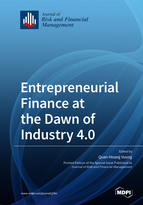Entrepreneurial Finance at the Dawn of Industry 4.0
A special issue of Journal of Risk and Financial Management (ISSN 1911-8074). This special issue belongs to the section "Business and Entrepreneurship".
Deadline for manuscript submissions: closed (30 June 2020) | Viewed by 42289
Special Issue Editor
Interests: emerging capital markets; data management; scientific data; applied statistics (frequentist and Bayesian); emerging market economics; financial database systems; sustainable financial management; entrepreneurial finance
Special Issues, Collections and Topics in MDPI journals
Special Issue Information
Dear Colleagues,
The forthcoming era of Industry 4.0 is expected to profoundly impact the world’s economy and the socioeconomic lives of billions of people. Entrepreneurs’ communities around the globe have already experienced early but tremendous changes and are starting to adapt to its emerging financial aspects, such as the rise of “computational entrepreneurship” (see: https://0-doi-org.brum.beds.ac.uk/10.21511/ppm.17(1).2019.11). It is the high time to seek to better understand the possible changes, both incremental and disruptive, in the ways that entrepreneurial firms, entrepreneurial endeavors, and perhaps entrepreneurial academics (thanks to the growing philanthropic funding to science and tech ventures) respond to their current and future financing needs. The need for this understanding will be increasingly important since entrepreneurial activities, and ventures gradually dominate the business landscape of the world, and their successes or failures will ultimately determine the future prosperity of societies. Therefore, this Special Issue invites scholarly and practicing researchers from different academic backgrounds to join hands in such an attempt to acquire new knowledge and insights into entrepreneurial finance at the dawn of Industry 4.0, by making scholarly contributions in the forms of original research (theoretical or empirical), academic discussions (conceptual discussion or perspectives), or literature reviews.
Dr. Quan-Hoang Vuong
Guest Editor
Manuscript Submission Information
Manuscripts should be submitted online at www.mdpi.com by registering and logging in to this website. Once you are registered, click here to go to the submission form. Manuscripts can be submitted until the deadline. All submissions that pass pre-check are peer-reviewed. Accepted papers will be published continuously in the journal (as soon as accepted) and will be listed together on the special issue website. Research articles, review articles as well as short communications are invited. For planned papers, a title and short abstract (about 100 words) can be sent to the Editorial Office for announcement on this website.
Submitted manuscripts should not have been published previously, nor be under consideration for publication elsewhere (except conference proceedings papers). All manuscripts are thoroughly refereed through a single-blind peer-review process. A guide for authors and other relevant information for submission of manuscripts is available on the Instructions for Authors page. Journal of Risk and Financial Management is an international peer-reviewed open access monthly journal published by MDPI.
Please visit the Instructions for Authors page before submitting a manuscript. The Article Processing Charge (APC) for publication in this open access journal is 1400 CHF (Swiss Francs). Submitted papers should be well formatted and use good English. Authors may use MDPI's English editing service prior to publication or during author revisions.
Keywords
- Microfinance, crow-funding
- Artificial intelligence (AI) and computational entrepreneurship
- Serendipity as a strategic advantage in entrepreneurial finance
- Governmental policy responses to entrepreneurs’ financial needs
- Finance and creative performance in Industry 4.0
- Philanthropic funding, scientific discoveries, and entrepreneurial finance
- Emerging regulatory framework amid the rise of Industry 4.0
- The role of financial markets
- Gender issues in entrepreneurial finance
- Risk management for entrepreneurial finance: tools, techniques, conceptual developments, and limitations





